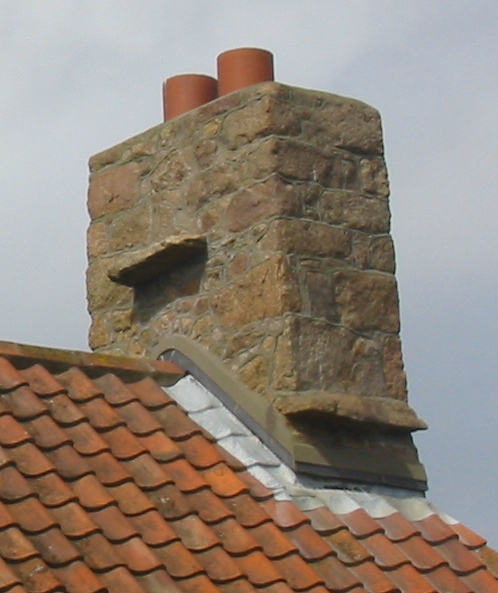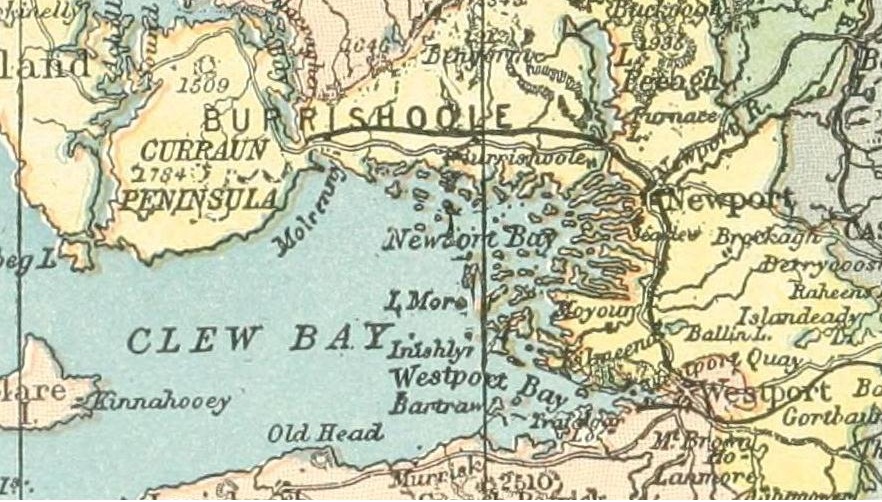|
Granuaile's Castle
Granuaile's Castle is a tower house and National Monument located in Clare Island, Ireland. Location Granuaile's Castle is located on the east coast of Clare Island. History Granuaile's Castle was built in the 16th century by the Ó Máille (O'Malley), Kings of Umaill. It was a stronghold of Gráinne Ní Mháille (Grace O'Malley, c. 1530 – c. 1603), the famous "pirate queen." Her other strongholds were at Rockfleet Castle (on Clew Bay) and Carrickkildavnet Castle. In the 1820s the castle was converted into a police barracks, when the purple slate flashing was added to the two bartizans. Building The main living room was at that first floor level with access to the bartizans and the garderobe Garderobe is a historic term for a room in a medieval castle. The ''Oxford English Dictionary'' gives as its first meaning a store-room for valuables, but also acknowledges "by extension, a private room, a bed-chamber; also a privy". The word der .... References {{Reflist Nat ... [...More Info...] [...Related Items...] OR: [Wikipedia] [Google] [Baidu] |
Clare Island
Clare Island ( or ''Oileán Chliara''), also historically Inishcleer, is a mountainous island guarding the entrance to Clew Bay in County Mayo, Ireland. Historically part of the kingdom of Umhaill, it is famous as the home of the 15th century pirate queen Gráinne O'Malley. The current population of the island is roughly 160. To the south-west lies Inishturk (inhabited) and Caher Island (uninhabited), and to the north is Achill Island. History Through the Middle Ages, Clare Island was part of the lands of the O'Malley family. The ruins of an O'Malley tower-house, known as Granuaile's Castle because of its most famous resident, are close to the pier at the eastern edge of the island. Clare Island Abbey near the south coast of the island was founded by the O'Malleys and contains the O'Malley Tomb, a possible burial site of Gráinne O'Malley. The Abbey is known for its rare medieval roof paintings. In 1588, a ship from the Spanish Armada was wrecked on Clare Island and its me ... [...More Info...] [...Related Items...] OR: [Wikipedia] [Google] [Baidu] |
Carrickkildavnet Castle
Carrickkildavnet Castle or Kildavnet Castle is a tower house and National Monument located in Achill Island, Ireland. Location Carrickkildavnet Castle is located in the southeast corner of Achill Island, across from the Corraun Peninsula. This is an important strategic site, protecting the mouth of Achill Sound and the passage that connects Clew Bay with Blacksod Bay. History Carrickkildavnet castle was built c. 1429 by the Ó Máille (O'Malley), Kings of Umaill. It was later the stronghold of Gráinne Ní Mháille (Grace O'Malley, c. 1530 – c. 1603), the famous "pirate queen." Her other strongholds were at Rockfleet Castle (on Clew Bay) and Clare Island. Building It is a tower house of four storeys' height. It is vaulted above the first floor and a hole at the corner of this vault is the only access to the higher levels, presumably for defensive reasons. Other defensive features include a mural chamber, machicolation, defensive loops, buttress fortifications at the top ... [...More Info...] [...Related Items...] OR: [Wikipedia] [Google] [Baidu] |
Garderobe
Garderobe is a historic term for a room in a medieval castle. The ''Oxford English Dictionary'' gives as its first meaning a store-room for valuables, but also acknowledges "by extension, a private room, a bed-chamber; also a privy". The word derives from the French , meaning "robes (or clothing) protector": thus, a closet or a toilet seat that would tend to prevent clothing from getting soiled. Its most common use now is as a term for a castle toilet. Store room is the French word for "wardrobe", a lockable place where clothes and other items are stored. According to medieval architecture scholar Frank Bottomley, garderobes were "Properly, not a latrine or privy but a small room or large cupboard, usually adjoining the chamber edroomor solar iving roomand providing safe-keeping for valuable clothes and other possessions of price: cloth, jewels, spices, plate and money." Toilet The term ''garderobe'' is also used to refer to a medieval or Renaissance toilet or a close stool ... [...More Info...] [...Related Items...] OR: [Wikipedia] [Google] [Baidu] |
Bartizan
A bartizan (an alteration of ''bratticing''), also called a guerite, ''garita'', or ''échauguette'', or spelled bartisan, is an overhanging, wall-mounted turret projecting from the walls of late medieval and early-modern fortifications from the early 14th century up to the 18th century. Most frequently found at corners, they protected a warder and enabled him to see his surroundings. Bartizans generally are furnished with oillets or arrow slits. The turret was usually supported by stepped masonry corbels and could be round, polygonal or square. Bartizans were incorporated into many notable examples of Scottish Baronial architecture. In the architecture of Aberdeen, the new Town House, built in 1868–74, incorporates bartizans in the West Tower. Gallery At walls File:Round Bartizan, Fortaleza de Santiago, Sesimbra, Portugal.JPG, ''Guarita'' at Fortaleza de Santiago, Sesimbra Municipality, Portugal. File:Sudika Isla watchtower.jpg, ''Gardjola'' at the Spur, Senglea, Malt ... [...More Info...] [...Related Items...] OR: [Wikipedia] [Google] [Baidu] |
Flashing (weatherproofing)
Flashing refers to thin pieces of impervious material installed to prevent the passage of water into a structure from a joint or as part of a weather resistant barrier system. In modern buildings, flashing is intended to decrease water penetration at objects such as chimneys, vent pipes, walls, windows and door openings to make buildings more durable and to reduce indoor mold problems. Metal flashing materials include lead, aluminium, copper, stainless steel, zinc alloy, and other materials. Etymology and related terms The origin of the term ''flash'' and ''flashing'' are uncertain, but may come from the Middle English verb ''flasshen'', 'to sprinkle, splash', related to ''flask''. ''Counter-flashing'' (or ''cover flashing'', ''cap flashing'') is a term used when there are two parallel pieces of flashing employed together such as on a chimney, where the counter-flashing is built into the chimney and overlaps a replaceable piece of ''base flashing''. Strips of lead used for flash ... [...More Info...] [...Related Items...] OR: [Wikipedia] [Google] [Baidu] |
Slate
Slate is a fine-grained, foliated, homogeneous metamorphic rock derived from an original shale-type sedimentary rock composed of clay or volcanic ash through low-grade regional metamorphism. It is the finest grained foliated metamorphic rock. Foliation may not correspond to the original sedimentary layering, but instead is in planes perpendicular to the direction of metamorphic compression. The foliation in slate is called "slaty cleavage". It is caused by strong compression causing fine grained clay flakes to regrow in planes perpendicular to the compression. When expertly "cut" by striking parallel to the foliation, with a specialized tool in the quarry, many slates will display a property called fissility, forming smooth flat sheets of stone which have long been used for roofing, floor tiles, and other purposes. Slate is frequently grey in color, especially when seen, en masse, covering roofs. However, slate occurs in a variety of colors even from a single locality; for ex ... [...More Info...] [...Related Items...] OR: [Wikipedia] [Google] [Baidu] |
Royal Irish Constabulary
The Royal Irish Constabulary (RIC, ga, Constáblacht Ríoga na hÉireann; simply called the Irish Constabulary 1836–67) was the police force in Ireland from 1822 until 1922, when all of the country was part of the United Kingdom. A separate civic police force, the unarmed Dublin Metropolitan Police (DMP), patrolled the capital and parts of County Wicklow, while the cities of Derry and Belfast, originally with their own police forces, later had special divisions within the RIC. For most of its history, the ethnic and religious makeup of the RIC broadly matched that of the Irish population, although Anglo-Irish Protestants were over-represented among its senior officers. The RIC was under the authority of the British administration in Ireland. It was a quasi-military police force. Unlike police elsewhere in the United Kingdom, RIC constables were routinely armed (including with carbines) and billeted in barracks, and the force had a militaristic structure. It policed Irela ... [...More Info...] [...Related Items...] OR: [Wikipedia] [Google] [Baidu] |
Clew Bay
Clew Bay (; ga, Cuan Mó) is a natural ocean bay in County Mayo, Republic of Ireland. It contains Ireland's best example of sunken drumlins. The bay is overlooked by Croagh Patrick to the south and the Nephin Range mountains of North Mayo. Clare Island guards the entrance of the bay. From the southwest part of the bay eastwards are Louisburgh, Lecanvey, Murrisk, and Westport; north of Westport is Newport, and westwards from there lies Mulranny, gateway to Achill. From the south side of the bay, between Clare Island and Achill, Bills Rocks can be seen. History The bay was anciently known in Irish as ''Cuan Mod'' 'h''("Mod Harbour") or ''Modlind'' ("Mod Pool"), and was associated with the Fir Bolg. Some writers claim that this name derives from Modh, one of the Tuatha Dé Danann. Another possibility is the Old Irish ''mod'', ''moth'', which meant "penis"; it is possible that the bay was imagined as a penis thrusting into the land. Another old name is ''Cuan Umaill'' ("h ... [...More Info...] [...Related Items...] OR: [Wikipedia] [Google] [Baidu] |
County Mayo
County Mayo (; ga, Contae Mhaigh Eo, meaning "Plain of the Taxus baccata, yew trees") is a Counties of Ireland, county in Republic of Ireland, Ireland. In the West Region, Ireland, West of Ireland, in the Provinces of Ireland, province of Connacht, it is named after the village of Mayo, County Mayo, Mayo, now generally known as Mayo Abbey. Mayo County Council is the Local government in the Republic of Ireland, local authority. The population was 137,231 at the 2022 census of Ireland, 2022 census. The boundaries of the county, which was formed in 1585, reflect the Mac William Íochtar lordship at that time. Geography It is bounded on the north and west by the Atlantic Ocean; on the south by County Galway; on the east by County Roscommon; and on the northeast by County Sligo. Mayo is the third-largest of Ireland's 32 counties in area and 18th largest in terms of population. It is the second-largest of Connacht's five counties in both size and population. Mayo has of coastline, ... [...More Info...] [...Related Items...] OR: [Wikipedia] [Google] [Baidu] |
Rockfleet Castle
Rockfleet Castle, or Carrickahowley Castle (Irish: ''Carraig an Chabhlaigh''), is a tower house near Newport in County Mayo, Ireland. It was built in the mid-fifteenth century, and is most famously associated with Grace O'Malley Grace O'Malley ( – c. 1603), also known as Gráinne O'Malley ( ga, Gráinne Ní Mháille, ), was the head of the Ó Máille dynasty in the west of Ireland, and the daughter of Eóghan Dubhdara Ó Máille. In Irish folklore she is commonly k ..., the 'pirate queen' and chieftain of the Clan O’Malley. The castle has been speculated as her place of death. It is also known as Carraigahowley, which means “rock of the fleet”. Rockfleet Castle has four floors and is over eighteen metres in height looking out towards the drumlins of Clew Bay. Though entry to the castle was once available to the public, it is now strictly prohibited for safety reasons. The castle was installed with a metal walkway in 2015, from its adjacent grassland surrounding t ... [...More Info...] [...Related Items...] OR: [Wikipedia] [Google] [Baidu] |


.jpg)




